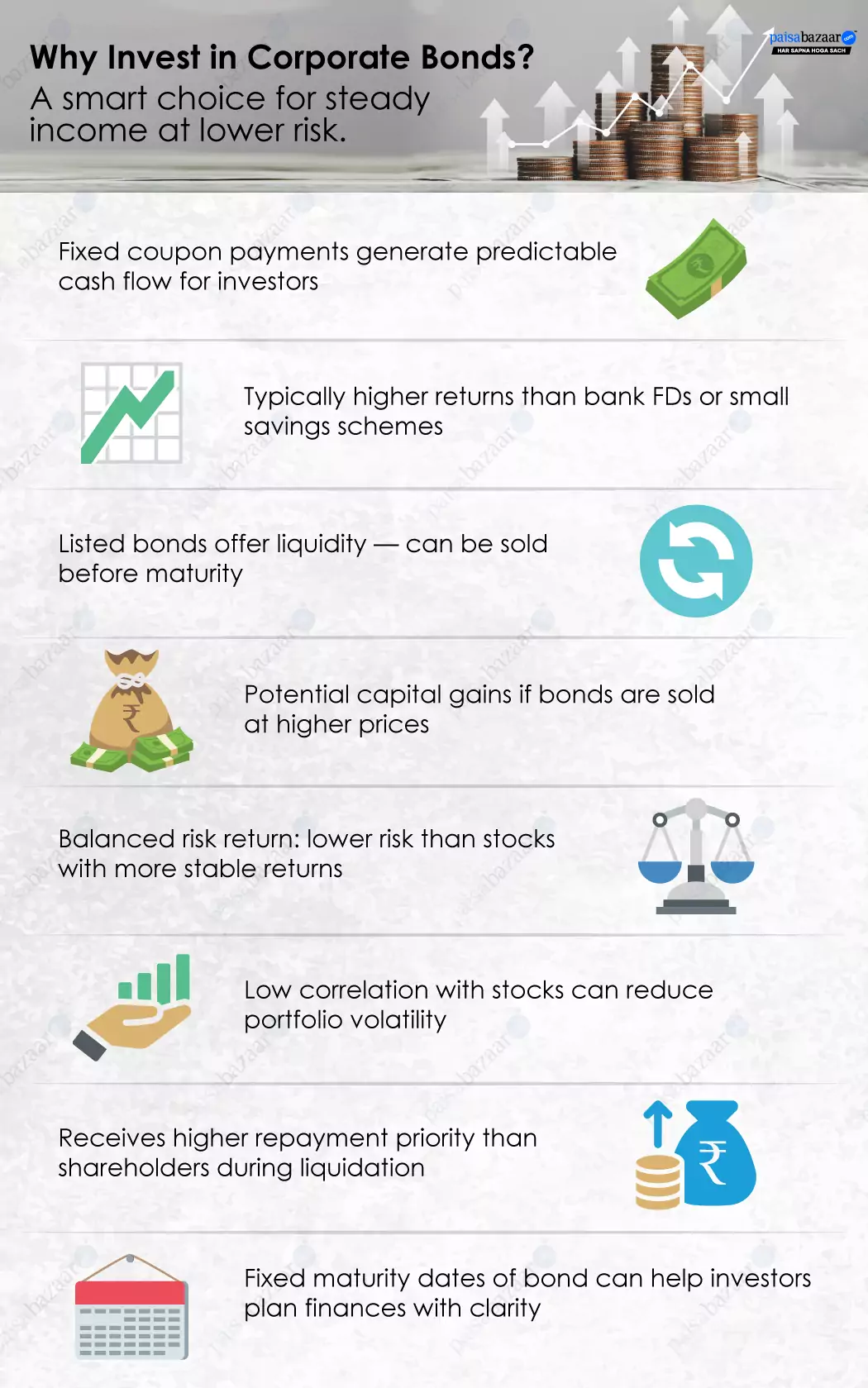What are Corporate Bonds
Corporate Bonds are issued by public & private sector companies to raise capital from investors. These bonds are debt instruments wherein the issuing company makes periodic interest payments to its investors and returns the principal amount on their maturity dates. These bonds serve as an important source of funding for companies looking to finance expansion, manage operations or refinance existing debt.
Why Invest in Corporate Bonds
- Corporate bonds provide a fixed income through periodic coupon payments, ensuring a steady cash flow for investors.
- Corporate bonds generate higher returns than bank FDs, small savings schemes and government bonds, providing an alternative for fixed income investors to earn higher interest income.
- Returns generated by corporate bonds are less correlated to stock returns, which helps in diversification of their investment portfolios and reduction in their volatility.
- Being debt instruments, bondholders receive higher repayment priority over shareholders in the event of the liquidation of the bond issuing company.
- While corporate bonds generate lower returns than stocks, they also carry lower risk. This makes corporate bonds an ideal investment instrument for those having lower risk appetite.
- The pre-determined dates of coupon (interest) and maturity payments in corporate bonds can help investors to align their cash inflows from bonds with their financial goals and provide more clarity to their financial planning objectives.
- Listed corporate bonds can be sold in secondary markets before their maturity dates.
- Factors like falling interest rates or credit rating upgrades can lead bond prices to appreciate, allowing their investors to book capital gains by selling those bonds before their maturity dates.
- Negative investor sentiment for a bond issuing company or its sector/segment can lead to a fall in its bond prices. Investors having moderate or higher risk appetite can exploit such opportunities to earn higher yields.

Risks Involved in Investing in Corporate Bonds
Although corporate bonds are often seen as safer than equities, they come with their own set of risks that investors must understand and manage wisely:
Credit Risk
Credit risk refers to the situation when the issuer may fail to make timely interest payments or repay the principal. To manage this risk, investors should evaluate the issuer’s financial strength and credit rating. Corporate bonds having higher credit rating have lower credit risk.
Prepayment Risk
Some corporate bonds allow issuers to repay the debt before their maturity dates, especially during a falling interest rate regime. While this benefits the bond issuer, it can leave their investors to invest the bond maturity proceeds in instruments offering lower returns. To guard against this, investors should carefully check for callability or buyback related clauses before investing.
Interest Rate Risk
Bond prices move inversely to interest rates—when rates rise, the market price of the bond falls and vice versa. This risk is higher in corporate bonds having longer residual maturity. Investors seeking to avoid this risk should aim at staying invested in their corporate bonds till their maturity dates.
Liquidity Risk
If a bond is not actively traded, it might be difficult to sell it at a fair price before its maturity date. Thus, a lack of liquidity can lead to losses or delays in converting the investment to cash. Choosing listed bonds having sizeable trading volume can help reduce this risk for the investor.
Classification of Corporate Bonds
Corporate bonds can be categorised on the basis of their periodicity of interest payments, type of interest rate, collateral attached, convertibility and buy-back features.
Corporate Bonds Classification in terms of Interest Rate Type
Fixed Rate Bonds
A fixed-rate bond offers periodic interest payments as per the interest rate fixed at the time of bond issuance. This interest payment, often called a coupon payment, is calculated as a percentage of the face value of the bond. The interest rate is called the coupon rate.
Floating Rate Bonds
A floating rate bond has its interest rate linked to a benchmark like government bond yields or the Mumbai Interbank Offered Rate (MIBOR), etc. As the benchmark rate fluctuates, the interest rate of the bond also fluctuates accordingly. Due to this dependency on the movement of the benchmark rate, the income certainty of the floating-rate bonds is much lower.
Zero Coupon Bonds
Zero coupon bonds do not provide periodic interest payments. These bonds are issued at a discount on the bond’s face value. The bondholder receives the face value of his investment on maturity. The investor purchasing a zero coupon bond profits from the difference between the purchase price and the face value of the bond.
Corporate Bonds Classification in terms of the Periodicity of Interest Payments
Cumulative Bonds
In case of cumulative bonds, their issuers pay back the interest income, accrued over the bond tenure, on their maturity dates. These bonds are suitable for investors who prefer growth over regular income.
Non-Cumulative Bonds
In case of non-cumulative bonds, the accrued interest income is paid out at regular intervals, viz, monthly, quarterly, semi-annually or annually, depending on the interest payment frequency set at the time of bond issuance. These bonds are suitable for investors requiring a steady income stream.
Corporate Bonds Classification in terms of Collateral
Secured Bonds
Secured bonds are backed by specific collateral pledged by the issuing company—such as real estate, machinery, or other tangible assets. In the event of a default or winding up of the bond issuers, the pledged assets of secured bonds can be sold to repay their investors. This added layer of security makes secured bonds less risky compared to unsecured bonds.
Secured bonds can be further classified into senior and junior (subordinated) bonds. Investors holding senior bonds receive higher priority in terms of claim on the issuing company’s assets during liquidation or defaults.
Unsecured Bonds
Unsecured bonds are not backed by any specific collateral of the bond issuing company.
Corporate Bonds Classification in terms of Convertibility
Convertible Bonds
Convertible Bonds can be converted into equity shares of the issuing company. The conversion can either take at a pre-determined price set at the time of the bond issuance or at the prevailing stock price at the time of conversion. As convertible bonds allow their investors to exercise of option of converting them into equity shares, the coupon rates offered on convertible corporate bonds are usually lower than their non-convertible counterparts.
Some companies issue corporate bonds that are to be compulsorily converted to equities on a preset date. Such bonds are known as compulsorily convertible bonds.
Non-Convertible Bonds
Corporate bonds that do not allow their investors the option of conversion to equities of the issuing company are known as non-convertible bonds.
Classification in terms of Buy-Back Options
Callable Corporate Bonds
These bonds allow their corporate issuers the right to exercise buybacks from their existing bond holders before their maturity dates.
Puttable Corporate Bonds
Puttable corporate bonds allow their investors to sell back their bonds before their maturity dates on pre-determined dates.
How to Invest in Corporate Bonds
The company can issue corporate bonds to raise capital through two primary methods: a public issue or a private placement.
Investing through Public Issue vs. Private Placement
In a public issue, the company invites the general public to subscribe to its bonds. Before doing so, the company must issue a prospectus stating details about the company and bonds to be issued – its face value, coupon rates, nature of the instrument (secured or unsecured), maturity dates/tenor, seniority (i.e. senior or sub-ordinate bonds), coupon payment frequency, etc. Once the public issue is completed, the bonds are listed on stock exchanges like NSE or BSE—making them listed bonds.
On the other hand, private placements are usually offered to a select group of persons (not exceeding 200 as per Companies Act, 2013) in addition to qualified institutional buyers.
Investing in Corporate Bonds through Primary Market vs Secondary Market
Investors can invest in listed bonds primarily through two routes:
- Primary Market: This is where an investor can buy bonds directly from the issuer during the initial offer period. The price of the bond can be set at par (i.e. at face value of the bond) or at a discount/premium.
- Secondary Market: Once a bond is listed on a stock exchange, investors can buy that bond directly from its existing investors through the stock exchange(s) at its market price.
Retail investors can purchase and sell corporate bonds through conventional stock brokers and OBPP (Online Bond Platform Providers).





